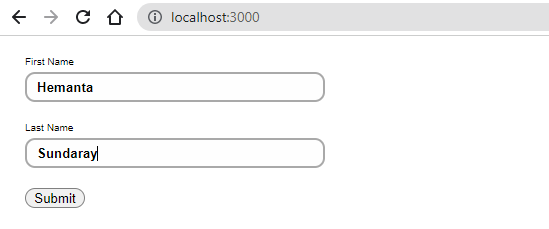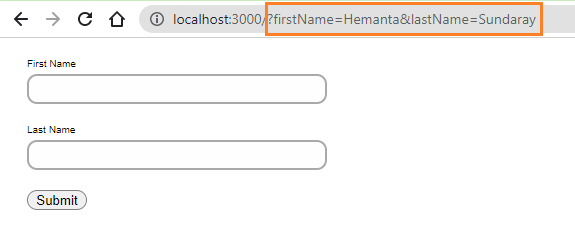An Introduction to React Forms
By Hemanta Sundaray on 2022-07-20
Controlled Components
In a typical non-React environment, a user types some data into a form’s input fields. The server remains clueless until the user hits a “Submit” button, which sends all of the form’s data over to the server simultaneously.
In React, this is not the best way of doing things.
In React, we want to update the server any time a user enters or deletes any character. The best way to do this is by listening for a “change” event on the <input />.
import React from "react"
import { useState } from "react"
const App = () => {
const [userInput, setUserInput] = useState("")
function handleUserInput({ target }) {
setUserInput(target.value)
}
return (
<>
<input
className="shadow border rounded py-2 px-3 m-2"
type="text"
onChange={handleUserInput}
value={userInput}
/>
<p className="ml-3">{userInput}</p>
</>
)
}
export default AppIn the example above, we have given <input /> an onChange attribute.
When a user types or deletes in the <input />, it triggers a change event, which calls the handleUserInput() event handler.
handleUserInput() sets userInput equal to whatever text is currently in the input field.
Then we control the <input />'s text by setting its value attribute. In React, when we give an <input /> a value attribute, the <input /> becomes a controlled component. It stops keeping track of its own text.
This way, we get an idiomatically correct React form.
Default Form Behavior
When we submit a form by pressing Enter or clicking on a submit button, the submit event fires and by default the browser initiates form submission to the server and submits the form data to the same URL - which results in a page reload.
import React, { useState } from "react"
const Login = () => {
const [formValue, setFormValue] = useState({ firstName: "", lastName: "" })
const handleSubmit = () => {
console.log(formValue)
}
const handleChange = ({ target }) => {
const { name, value } = target
setFormValue({
...formValue,
[name]: value,
})
}
return (
<form onSubmit={handleSubmit}>
<label htmlFor="firstName">First Name</label>
<input
id="firstName"
name="firstName"
value={formValue.firstName}
onChange={handleChange}
/>
<label htmlFor="lastName">Last Name</label>
<input
id="lastName"
name="lastName"
value={formValue.lastName}
onChange={handleChange}
/>
<button type="submit">Submit</button>
</form>
)
}
export default LoginIf I fill in the form and click on the Submit button,
we will see the default form submission behavior in action.
We can prevent this default behavior by using the preventDefault method on the submit event.
import React, { useState } from "react"
const Login = () => {
const [formValue, setFormValue] = useState({ firstName: "", lastName: "" })
const handleSubmit = e => {
e.preventDefault()
console.log(formValue)
}
const handleChange = ({ target }) => {
const { name, value } = target
setFormValue({
...formValue,
[name]: value,
})
}
return (
<form onSubmit={handleSubmit}>
<label htmlFor="firstName">First Name</label>
<input
id="firstName"
name="firstName"
value={formValue.firstName}
onChange={handleChange}
/>
<label htmlFor="lastName">Last Name</label>
<input
id="lastName"
name="lastName"
value={formValue.lastName}
onChange={handleChange}
/>
<button type="submit">Submit</button>
</form>
)
}
export default LoginNow, if I fill the form and hit the Enter button, we will not see a page refresh.
What you do with the form data is entirely up to you. Though, most of the time, we send this form data to a backend API using a HTTP Client (axios for example) or the Fetch API (built into browsers) and save the user information in a database.
React Form Libraries
In the real world, you will most likely use a library to build forms for your React apps. Libraries make it easier to handle form state, form validation and error messages.
The following are some of the libraries that I see being used often:
If you want to build forms with Formik, I have written a blog post (as part of a series). Check out here.


